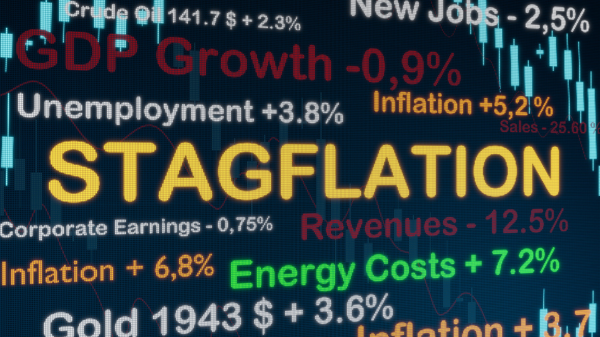Are we on verge of stagflation? Two of America’s biggest banks have just warned of incoming disaster. (Commentary)
by Peter St. Onge
Two of America’s biggest banks just warned of incoming disaster.
Even poker-face Federal Reserve Chairman Jerome Powell is starting to crack, sprinkling his usual sweet nothings with warnings that the Fed’s close to being forced to restart the money printers despite galloping inflation.
The warnings come from JP Morgan, whose CEO Jamie Dimon warns that inflation will stay higher for longer than markets think, driven by massive federal deficits.
He warns this higher inflation would also keep interest rates high, which could crash smaller companies who are running out of cash. It would also keep mortgages and credit cards at rates slightly higher than the mafia charges.
Incidentally, Dimon is the front-runner for Treasury secretary in a prospective second term for former President Donald Trump, so he’ll have Trump’s ear.
The second warning comes from Citigroup, which put out a new report predicting what Zerohedge calls a “rate-cut bomb”—a near-panicked series of 10 interest-rate cuts starting in a few months and running all the way to next July.
That’s something that only happens when the economy careens into recession, when the Fed desperately pumps rescue meds—that is, rate cuts—to an economy that’s flat-lined.
Put them together, and Dimon thinks inflation will keep running. Citi thinks the economy will collapse. We have a name for that—stagflation.
Now, normally, when the economy crashes, the Fed lowers interest rates to pump up spending. But all that new money also drives up inflation, so it’s always a trade-off between growth and inflation.
The problem is when both crash and inflation come at once. The Fed’s standard tools aren’t built to handle that, because it’s not supposed to happen.
That means the Fed is winging it—or as Powell famously put it last year, “navigating by the stars under cloudy skies.” Put differently, they have no idea what they’re doing.
Stagflation’s been on our radar for a few years now, ever since the money-printing orgy of the 2020 lockdowns set off the worst inflation in 50 years, followed by the most savage rate hikes in 50 years.
The biggest surprise has been how long it’s taken, apparently postponed by trillion-dollar deficits and yet more trillions in private debt from credit cards to car loans.
Of course, that put it off, but it actually made it worse, now posing stagflation on an American public that’s basically drowning in debt.
While all this looks pretty gloomy, there are two big factors that could head off stagflation: geopolitics and Donald Trump.
Geopolitics, meaning if the wars end tomorrow, we could see crashing oil prices along with a reduction in systemic risk that would boost investment. This would take the edge off inflation, and it could at least slow job losses.
The bigger factor is Trump. A few days ago, I outlined his pro-growth agenda for a second term, from regulation to taxes to ending those wars.
That would definitely boost growth, which reduces inflation. And even if Trump is at least six months away, markets are already reacting, with Trump-sensitive sectors like energy rising as a Trump win becomes more likely on the betting markets.
Still, even if help is on the way, it’s almost certainly too late to avoid the stagflation altogether: Economies move on a long lag, and even without bank warnings, mass layoffs and faltering consumers tell us the stagflation is already on our doorstep.
Peter St. Onge is a visiting fellow at The Heritage Foundation.
Originally published by The Daily Signal. Republished with permission.
For more Budget & Tax News.











